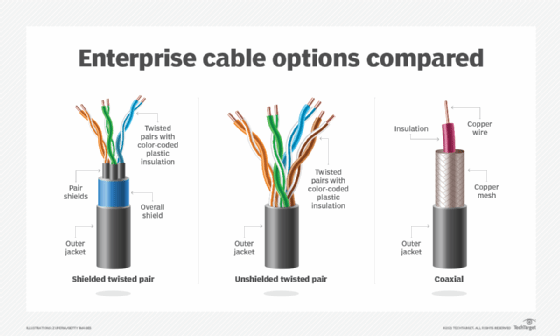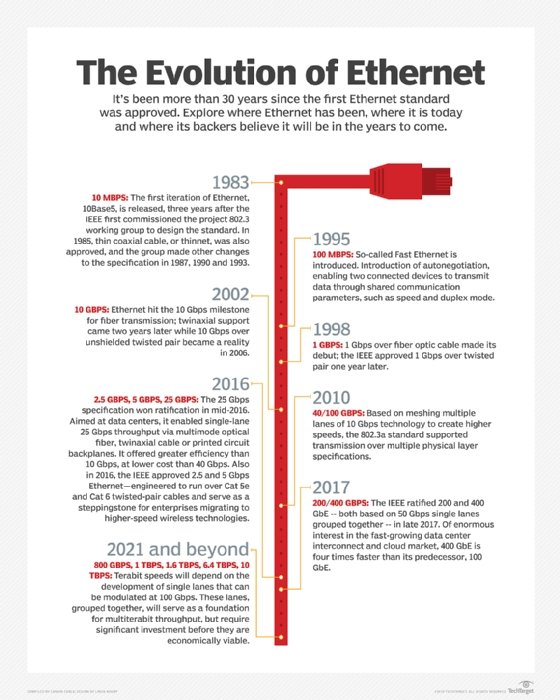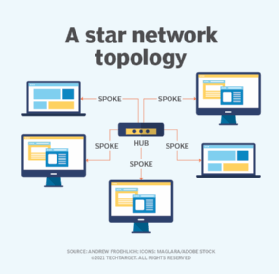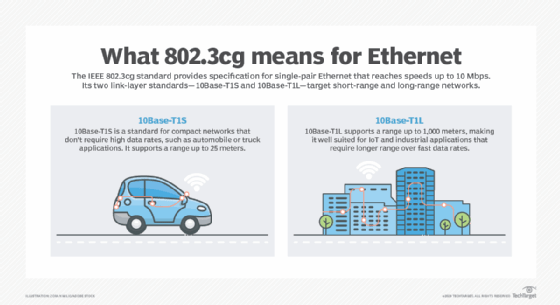10BASE-T
What is 10BASE-T?
10BASE-T is an Ethernet standard for local area networks and one of several physical media specified in the Institute of Electrical and Electronics Engineers (IEEE) 802.3 standard. 10BASE-T supports 10 megabits per second (Mbps) transmission speed over twisted-pair cabling with a maximum length of 100 meters (m). The twisted-pair cables connect with an RJ45 connector.
10BASE-T is a shorthand identifier designated by IEEE. The 10 refers to a maximum transmission speed of 10 Mbps. BASE refers to baseband signaling, which means that it can only carry Ethernet signals on the medium. T refers to twisted as in twisted-pair cabling.
In the 1980s, inexpensive twisted-pair wires were widely used to deploy 10BASE-T, which was easier to install than thick and thin coaxial cables. 10BASE-T Ethernet was also the first version of Ethernet to use a star architecture.
Used with a hub, 10BASE-T shares the 10 Mbps bandwidth with different ports. 10BASE-T can also be used with a switch that has full 10 Mbps transmit and receive pairs.

What is 10BASE-T/100BASE-TX/1000BASE-T?
Almost no new products come with just 10BASE-T. Most hubs, switches and Ethernet adapters in the market are 10BASE-T/100BASE-TX/1000BASE-T devices. This means that it supports 10, 100 and 1,000 Mbps data transmissions, respectively. There is also 10GBASE-T, which supports 10 gigabits per second (billions of bits) data transmissions.
In addition to 10BASE-T, 10 Mb Ethernet can also be implemented with the following media types:
- 10BASE-2. Thin wire coaxial cable with a maximum segment length of 185 m.
- 10BASE-5. Thick wire coaxial cable with a maximum segment length of 500 m.
- 10BASE-F. Optical fiber
- 10BASE-36. Broadband coaxial cable carrying multiple baseband channels for a maximum length of 3,600 m.
In the above, F represents fiber optic cable, and 2, 5 and 36 refer to the coaxial cable segment length -- the first, representing the 185 m length rounded up to 2 for 200.

How does 10BASE-T work?
10BASE-T networks are usually wired together to a central hub in a star topology. The cables used for the unshielded twisted-pair wiring are Category 3, 4 or 5. Wires are terminated with RJ45 connectors.
Patch panels organize the wiring and establish termination points for cables running inside walls, and patch cables connect each port on a patch panel to the central hub. Wiring is hidden inside a wiring cabinet or organized on a rack for easy access.
Since the maximum length of a cable in a 10BASE-T network is 100 m, repeaters are needed for longer distances. Two or more segments -- with the minimum length of a segment being 2.5 m -- connect using repeaters.
Cascading regular hubs or stackable hubs are used to network many computers. However, they only support a maximum of 1,024 nodes. In this scenario, a maximum of 200 or 300 nodes avert collisions and achieve the best performance.

How do you terminate a 10BASE-T cable?
10BASE-T cables are terminated with a Mod-Tap or similar wall jack to terminate the connection inside the wall.
What is 10BASE-T1L?
10BASE-T1L is an Ethernet physical layer standard approved by IEEE in late 2019 as part of the 802.3cg specification. 10BASE-T1L helps achieve seamless Ethernet connectivity for field-level devices, like sensors. The L in 10BASE-T1L stands for long distances of up to 1 kilometer.
It significantly enhances process automation protocols that enable operational efficiency. For example, 10BASE-T1L helped overcome challenges related to cabling, bandwidth, data islands, distance, and power in the field of process automation.

What is 10BASE-T1S?
10BASE-T1S, or 10 Mbps Single Pair Ethernet, is also a relatively new technology approved by IEEE with 802.3cg. The S in 10BASE-T1S stands for short reach. This variant uses a multidrop topology, where each node connects to a single cable. It is an approach that eliminates the need for switches and, as a result, fewer cables.
Typically, Ethernet cabling comes with four pairs of wires. However, 10BASE-T1S cables use one pair of twisted wires. According to IEEE, at least eight nodes can connect to each, but more connections are possible.
The primary goal of 10BASE-T1S is deterministic transmission on a multidrop network that's collision-free. It is used in applications using Controller Area Network, CAN Flexible Data Rate or 100BASE-T1. The Physical Layer Collision Avoidance protocol ensures that it uses the entire 10 Mbps bandwidth.
10BASE-T1S also supports an arbitration scheme that guarantees seamless node access to the media within a predefined time period.







